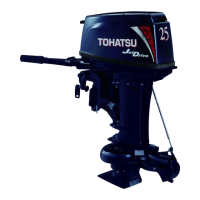ENGINE OPERATION
■
Engine speed
Idling speed after warming up.
Remark: In case of cold engine starting,
idling speed is increased about 300
rpm for several minutes.
■
Propeller selection
Propell e r m u s t be se lected that
w i l l a l l o w t h e e n g i n e t o re a c h
recommended rpm when cruising at
wide-open throttle.
Genuine propellers a re listed on
PROPELLER TABLE of this manual.
5
37
Model
Clutch in
(In gear)
Clutch off
(Out of gear)
25H, 30H
40C
900 rpm
850 rpm
1,050 rpm
950 rpm
Model Wide-open throttle rpm range
25H 5,000 - 6,000 rpm
30H 5,150 - 5,850 rpm
40C 5,200 - 5,800 rpm
3. Forward and reverse
Before shifting into forward or reverse,
make sure that boat is properly
moored and outboard motor can be
steered fully to the right and left. Make
sure that no swimmer(s) is ahead or
astern of the boat.
• Attach other end of emergency
stop switch tether to the operator's
clothing or arm and keep it
attached during cruising.
• Do not attach the tether to a part
of clothing that can be torn easily
when pulled.
•
Arrange the tether so that will not be
caught by any object when pulled
.
• Be careful not to pull the tether
accidentally during cruising.
Unintentional stop of engine can
cause loss of control of outboard
motor. Rapid loss of engine power
can lead to falling down or causing
passenger(s) to be thrown overboard
.
Note
Do not increase engine speed
unnecessarily in reverse.
Be sure to stop engine immediately
if cooling water check port is not
discharging water, and check if cooling
water intake is blocked. Operating
engine could lead to overheating
potentially leading to engine damage.
Consult an authorized dealer if the
cause cannot be found.
Note
Confirm that the reverse lock lever is at
“LOCK” position before running your
motor.

